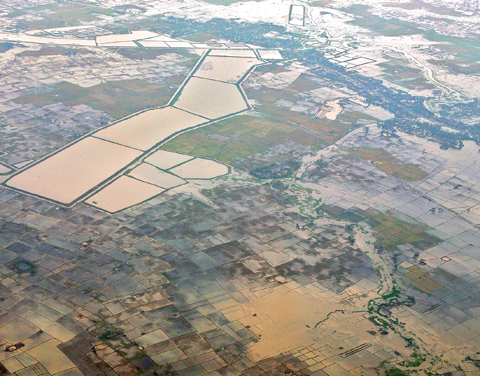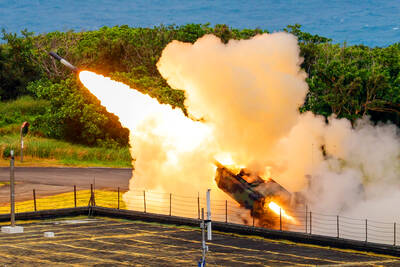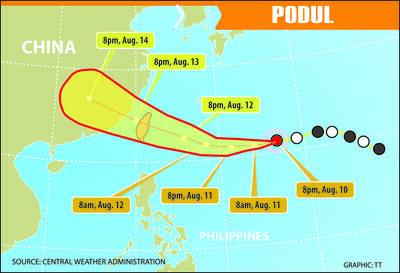The death toll from the cyclone that battered Myanmar last weekend rose above 22,000 yesterday, with at least 41,000 missing as the international community prepared to rush in aid, state radio reported.
A news broadcast on government-run radio said that 22,464 people have now been confirmed dead from Cyclone Nargis, which tore through the country’s rice bowl and biggest city of Yangon early on Saturday.
Of the dead, only 671 were in Yangon and its outlying districts, state radio said, confirming Nargis as the most devastating cyclone to hit Asia since 1991, when 143,000 people died in Bangladesh.

PHOTO: AFP/ROYAL THAI AIR FORCE
“More deaths were caused by the tidal wave than the storm itself,” Minister for Relief and Resettlement Maung Maung Swe told a news conference in Yangon, where food and water supplies are running low.
“The wave was up to 12 feet [3.5m] high and it swept away and inundated half the houses in low-lying villages,” he said, giving the first detailed description of the weekend cyclone.
“They did not have anywhere to flee,” he said.
Earlier, Foreign Minister Nyan Win said on state TV that 10,000 people had died just in Bogalay, a town 90km southwest of Yangon.
Information Minister Kyaw Hsan said the military were “doing their best,” but analysts said there could be political fallout for the military rulers, who pride themselves on their ability to cope with any challenge.
“The myth they have projected about being well-prepared has been totally blown away,” said political analyst Aung Naing Oo, who fled to Thailand after a brutally crushed 1988 uprising. “This could have a tremendous political impact in the long term.”
Relief efforts for the stricken area, mostly in the low-lying Arrawaddy (Irrawaddy) River delta, have been difficult, in large part because of the destruction of roads and communications outlets by the storm.
In the cyclone’s aftermath, state radio reported that the government was delaying a constitutional referendum in areas hit hardest.
Saturday’s vote on a military-backed draft constitution would be delayed until May 24 in 40 of 45 townships in the Yangon area and seven in the Arrawaddy delta, the radio said.
The report indicated that the balloting would proceed in other areas as scheduled.
The UN World Food Programme (WFP), which was preparing to fly in food supplies, offered a grim assessment of the destruction: up to 1 million people possibly homeless, some villages almost totally destroyed and vast rice-growing areas wiped out.
“We hope to fly in more assistance within the next 48 hours,” WFP spokesman Paul Risley said in Bangkok. “The challenge will be getting to the affected areas with road blockages everywhere.”
Based on a satellite map made available by the UN, the storm’s damage was concentrated over a 30,000km2 area along the Andaman Sea and Gulf of Martaban coastlines — less than 5 percent of the country. But the affected region is home to nearly a quarter of Myanmar’s 57 million people.
Aid agencies reported their assessment teams had reached some areas of the largely isolated region but said getting in supplies and large numbers of aid workers would be difficult.
Richard Horsey, Bangkok-based spokesman for the UN Office for the Coordination of Humanitarian Aid, said the airport closest to the delta region was in Yangon.
“For those places accessible by land, there will be cars and trucks from those areas to meet at the halfway point with vehicles from Yangon,” he said. “For remote areas, assessment teams and assistance teams will need to go by helicopters and boats.”
A military transport plane flew from Bangkok to Yangon yesterday with emergency aid from Thailand while a number of other countries and organizations said they were prepared to follow.
The US said it stood ready, but that a US disaster team must be invited into the country.
First lady Laura Bush, who has been the Bush administration’s chief voice on human rights and political conditions in Myanmar, faulted the junta for proceeding with the constitutional referendum and criticized government leaders for not sufficiently warning citizens about the storm.
“We know already that they are very inept,” she said.
“Our biggest fear is that the aftermath could be more lethal than the storm itself,” said Caryl Stern, who heads the UN Children’s Fund (UNICEF) in the US.
Other countries, from Canada to the Czech Republic and Singapore, reacted quickly with pledges of aid. The European Commission was providing US$3.1 million in humanitarian aid.
Also See: How to sell activism

DEFENSE: The first set of three NASAMS that were previously purchased is expected to be delivered by the end of this year and deployed near the capital, sources said Taiwan plans to procure 28 more sets of M-142 High Mobility Artillery Rocket Systems (HIMARS), as well as nine additional sets of National Advanced Surface-to-Air Missile Systems (NASAMS), military sources said yesterday. Taiwan had previously purchased 29 HIMARS launchers from the US and received the first 11 last year. Once the planned purchases are completed and delivered, Taiwan would have 57 sets of HIMARS. The army has also increased the number of MGM-140 Army Tactical Missile Systems (ATACMS) purchased from 64 to 84, the sources added. Each HIMARS launch pod can carry six Guided Multiple Launch Rocket Systems, capable of

Authorities have detained three former Taiwan Semiconductor Manufacturing Co (TMSC, 台積電) employees on suspicion of compromising classified technology used in making 2-nanometer chips, the Taiwan High Prosecutors’ Office said yesterday. Prosecutors are holding a former TSMC engineer surnamed Chen (陳) and two recently sacked TSMC engineers, including one person surnamed Wu (吳) in detention with restricted communication, following an investigation launched on July 25, a statement said. The announcement came a day after Nikkei Asia reported on the technology theft in an exclusive story, saying TSMC had fired two workers for contravening data rules on advanced chipmaking technology. Two-nanometer wafers are the most

TRAJECTORY: The severe tropical storm is predicted to be closest to Taiwan on Wednesday and Thursday, and would influence the nation to varying degrees, a forecaster said The Central Weather Administration (CWA) yesterday said it would likely issue a sea warning for Tropical Storm Podul tomorrow morning and a land warning that evening at the earliest. CWA forecaster Lin Ting-yi (林定宜) said the severe tropical storm is predicted to be closest to Taiwan on Wednesday and Thursday. As of 2pm yesterday, the storm was moving west at 21kph and packing sustained winds of 108kph and gusts of up to 136.8kph, the CWA said. Lin said that the tropical storm was about 1,710km east of Oluanpi (鵝鑾鼻), Taiwan’s southernmost tip, with two possible trajectories over the next one

CHINA’s BULLYING: The former British prime minister said that he believes ‘Taiwan can and will’ protect its freedom and democracy, as its people are lovers of liberty Former British prime minister Boris Johnson yesterday said Western nations should have the courage to stand with and deepen their economic partnerships with Taiwan in the face of China’s intensified pressure. He made the remarks at the ninth Ketagalan Forum: 2025 Indo-Pacific Security Dialogue hosted by the Ministry of Foreign Affairs and the Prospect Foundation in Taipei. Johnson, who is visiting Taiwan for the first time, said he had seen Taiwan’s coastline on a screen on his indoor bicycle, but wanted to learn more about the nation, including its artificial intelligence (AI) development, the key technology of the 21st century. Calling himself an